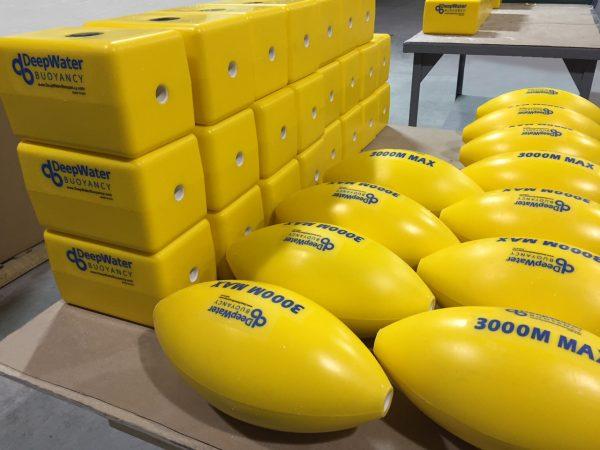/2016 Archive
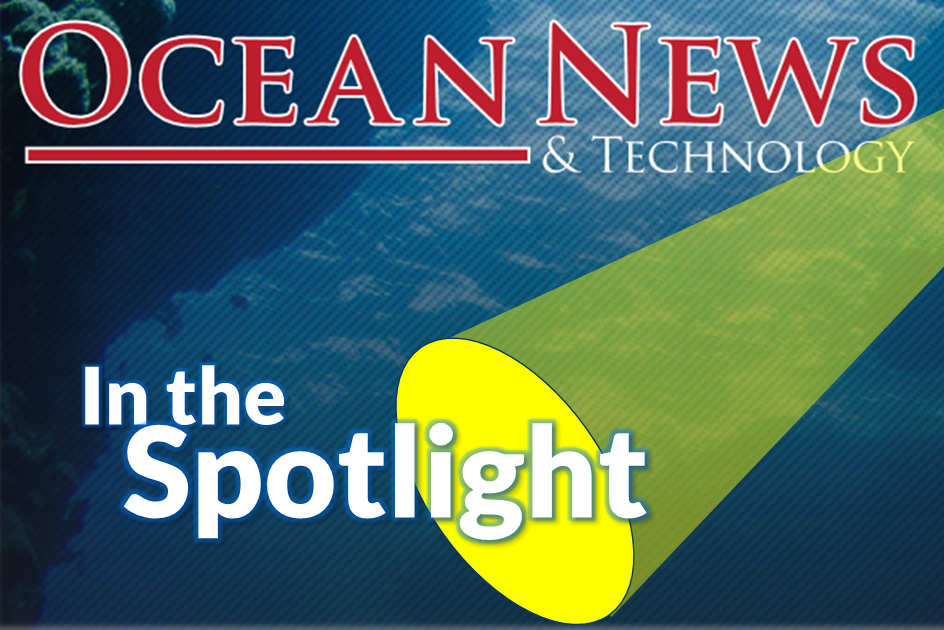
Dec 16, 2016
DeepWater Buoyancy was featured in the December issue of Ocean News and Technology (LINK). The full page article gives a bit of our history, as well as an overview of our products and capabilities.
Download a PDF of the article HERE…
…or read the full text of the article below.
DeepWater Buoyancy, Inc.
Rising to Your Undersea Challenges®

DeepWater Buoyancy Inc. is the world’s largest producer of subsea buoyancy products for the oceanographic industry and has a vast product line of buoyancy solutions for offshore oil & gas, energy and technology companies. This product portfolio has been built over the course of 35 years serving these industries. Though they offer products for shallow water applications, the company specializes in deepwater, providing solutions to depths of 6000 meters and beyond.
DeepWater Buoyancy’s headquarters and manufacturing operations are located in New England, the birthplace of syntactic foam. New England is also where David Cook formed Flotation Technologies (Flotec). Incorporated in 1979, Flotec grew into a recognized world leader in the manufacture of deepwater buoyancy products that included ADCP Buoys, distributed buoyancy modules and drilling riser buoyancy. Flotec was purchased in 2008 by a subsea equipment manufacturer.
In 2013, DeepWater Buoyancy acquired the rights and designs for the legacy Flotec material technology and products when its parent company was in the process of closing the New England facility. Since then, DeepWater Buoyancy has been producing, improving and growing the Flotec product line, which has been the industry standard for decades. DeepWater Buoyancy also stocks parts for these legacy products and provides design and application assistance.
The founder of DeepWater Buoyancy is former Flotec President, David Capotosto. Shortly after opening the doors of DeepWater Buoyancy, Mr. Capotosto was joined by three other former members of Flotec’s senior management team. This team of four now owns and manages DeepWater Buoyancy. The vision in creating DeepWater Buoyancy was to continue the Flotec commitment to designing and manufacturing the very best buoyancy solutions, and to provide the highest level of support for customers using the products. To that end, one of the first initiatives taken was to re-establish the international network of representatives and distributors operating in the oceanographic market. This network provides in-country sales, service, support, and application assistance in over 35 countries.
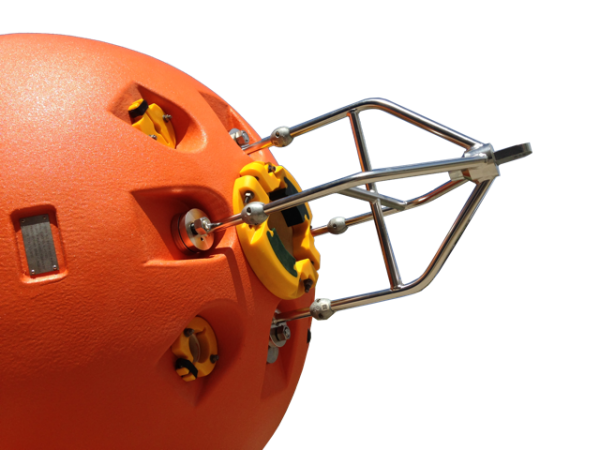
DeepWater Buoyancy’s 62 inch spherical ADCP buoy with integral frame, clamps and instrument pockets.
At the heart of the DeepWater Buoyancy product line are the subsurface ADCP buoys. These buoys, originally developed for Teledyne RD Instruments’ ADCPs, are considered the gold standard within the industry. Consisting primarily of both spherical and elliptical buoys, the product line also includes the unique StableMoor® Mooring Buoys. These torpedo-shaped buoys are engineered to house ADCPs and other sensors for high current data collection applications. By design, the StableMoor® reduces drag and increases mooring stability in extreme flow regimes, thereby producing superior data sets.
However, DeepWater Buoyancy’s product line goes well beyond ADCP buoys. In the oceanographic market there are bottom mounts, instrument collars, and cable floats. For offshore oil & gas, there are installation blocks, modular buoys, deepwater marker floats and ROV buoyancy. In addition to DeepTec® syntactic foam products and custom-engineered components, there are also polyurethane and fabricated metal products for use subsea.
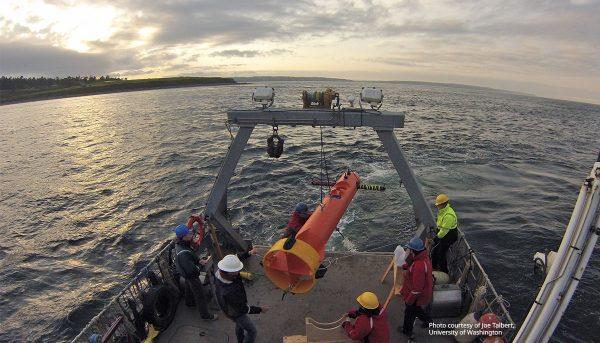
If a client can’t find their ideal solution in the product line, DeepWater Buoyancy will design and produce a custom product. The company’s design philosophy is, “A customer should have a product that meets the application, and not be forced to adjust their application to an off-the-shelf product.” Whether that is modifying an existing design or starting with a blank sheet of paper, the goal is to produce the finest, most cost-effective solution for any given application.
With a deep understanding of customers’ subsea operations, a long history of providing solutions to complex buoyancy applications, and a state of the art manufacturing facility, DeepWater Buoyancy is well-positioned to meet the challenges of this rapidly-evolving technology.
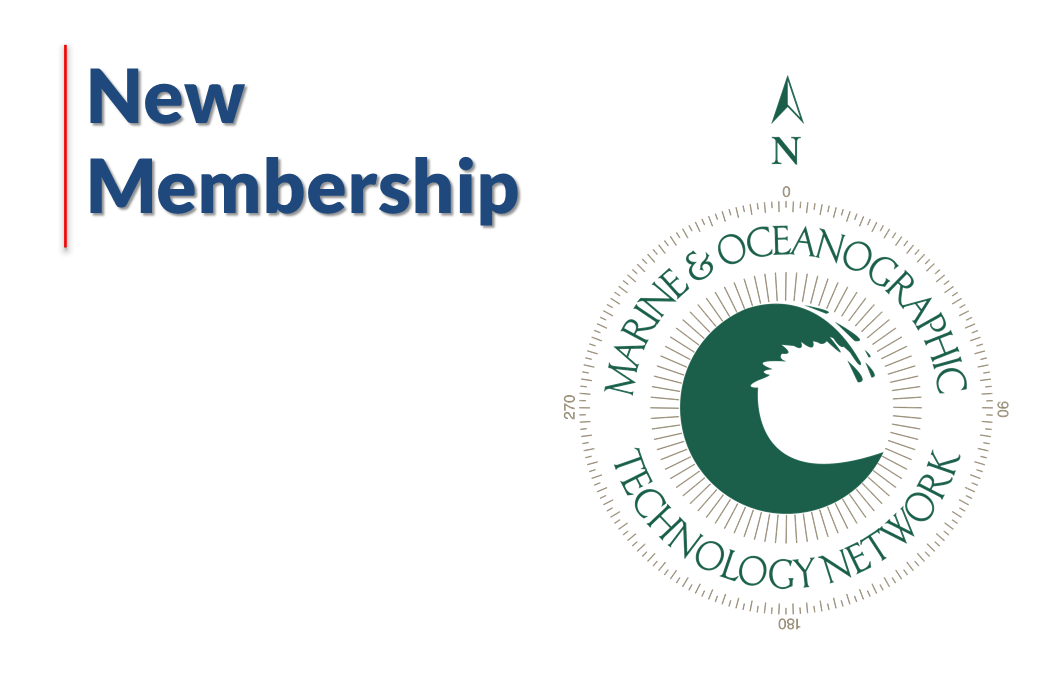
Nov 9, 2016
DeepWater Buoyancy is now a member of the Marine & Oceanographic Technology Network (MOTN).
The Marine & Oceanographic Technology Network is a non-profit corporation with the express purpose of promoting, supporting, and expanding the marine technology manufacturing and service businesses. MOTN fosters cooperation between, and opportunities for, its member companies. Member companies include industry suppliers, consultants, representatives, research institutes and manufacturers, working together to increase business opportunities both within and outside of the organization.
Learn more about MOTN here… http://www.motn.org/

Oct 5, 2016
DeepWater Buoyancy, Inc. announced the delivery of a significant follow-on order of diver-serviceable bottom mounts for one of the world’s largest fish farming companies. The bottom mounts are set on the seafloor at a depth of 50 to 100 meters and allow for the proper deployment of ADCPs to monitor the environment around the fish farm cages.
ADCP’s are used in aquaculture applications in order to monitor currents and waves for the following main purposes:
- Investigate new fish farming areas
- Monitor currents when feeding in order to minimize feed loss
- Monitor fish waste for pollution plumes
The order was secured by DeepWater Buoyancy’s UK representative, Saderet Ltd. Saderet is the exclusive distributor of DeepWater Buoyancy products in the UK. Saderet also represents Teledyne RD Instruments, makers of the Sentinel V50 ADCP, which was chosen for this application.
DeepWater Buoyancy, Inc.’s recently retooled BTM-AL50 diver-serviceable bottom mount line is equipped with a two-axis gimbal to mount an ADCP, clamps for a remote battery housing, and zinc anodes for corrosion resistance. The three articulating footpads are provided with standard urethane-coated ballast, with additional ballasting provided for this application.
The client was pleased with the performance, delivery, and quality of the equipment supplied in the first order, as well as the ongoing technical support provided by Saderet, DeepWater Buoyancy and Teledyne RDI.
About Saderet Ltd.
Saderet Ltd. specialize in the supply of survey and positioning equipment and services to a wide variety of markets including marine and land survey, GIS, oceanography, precision agriculture, and OEM. Presenting some of the best manufacturers of survey related equipment in the world, we deliver products worldwide.
www.saderet.co.uk
About DeepWater Buoyancy, Inc.
DeepWater Buoyancy creates subsea buoyancy products for leading companies in the oceanographic, seismic, survey, military and offshore oil & gas markets. Customers have relied on our products for over thirty-five years, from the ocean surface to depths exceeding six thousand meters.
www.DeepWaterBuoyancy.com


Save
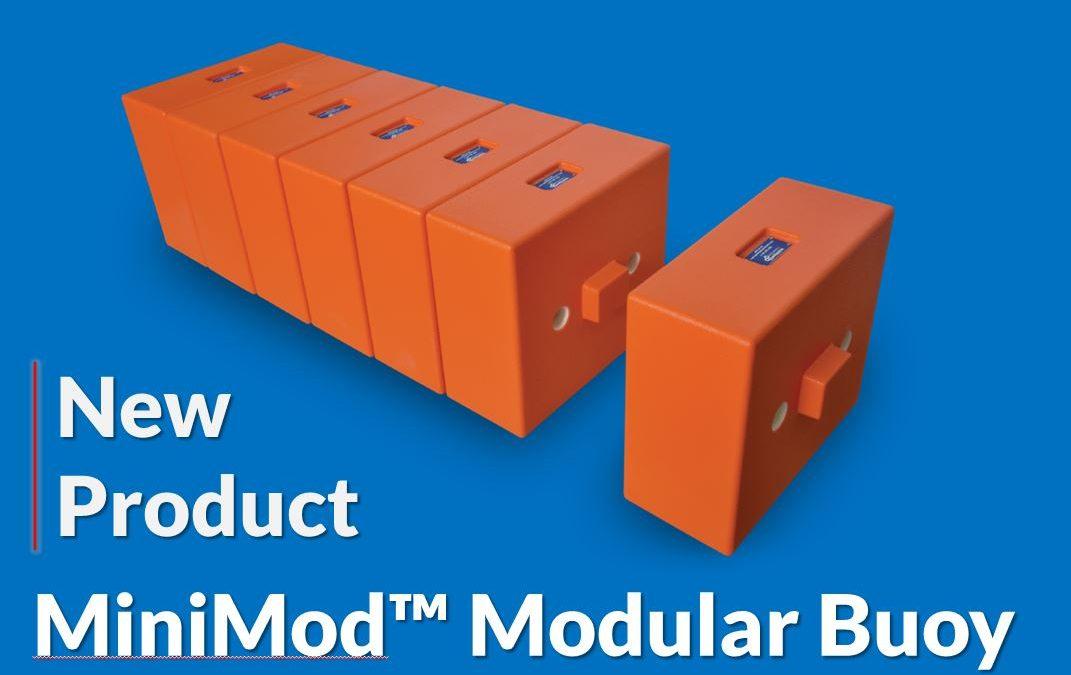
Aug 30, 2016
DeepWater Buoyancy, Inc. announced today that it has added a new buoyancy product for subsea installation applications. The MiniMod™ small modular buoy is a buoyancy system that allows the end user to quickly and easily vary the amount of buoyancy for different projects.
Our current modular buoys are the most versatile approach to buoyancy for offshore applications. They are offered in a variety of standard sizes with buoyancy as great as 2 metric tons and depth ratings to 6000 meters. For installation of pipeline sleds, jumpers, or suspended moorings, this multi-purpose product offers a straightforward way to meet buoyancy requirements.
Our MiniMod™ small modular buoys are designed for lighter applications. Still rated to depths as great as 6000 meters, the standard 7-module buoy can provide up to 325 kg of buoyancy. Made from high-strength DeepTec™ solid syntactic foam that is finished with an abrasion-resistant, polyurethane elastomer coating, these buoys can stand up to rough handling on-deck and in the water.
The syntactic foam modules are held together and handled by use of synthetic straps, as opposed to metal hardware. These straps have numerous benefits including corrosion resistance, ease of handling, and no loss of buoyancy. Modules interlock for added strength and can easily be added or removed for your application.
With rugged construction and the world’s most reliable, field-proven syntactic foams, these truly modular buoys provide offshore users with years of trouble-free service.
Download a datasheet HERE
See all our product types HERE
About DeepWater Buoyancy, Inc.
DeepWater Buoyancy creates subsea buoyancy products for leading companies in the oceanographic, seismic, survey, military and offshore oil & gas markets. Customers have relied on our products for over thirty-five years, from the ocean surface to depths exceeding six thousand meters.
For further sales information: Dan Cote, Sales Manager | sales@deepwb.com | +1 207 502 1400
For further company information: David A. Capotosto | davidcap@deepwb.com | +1 207 468 8545

Aug 29, 2016
For the next installment in our series of technical articles, ocean engineer Jon Wood addresses an interesting question related to deployment and recovery of subsea mooring systems. Jon has decades of experience working with DeepWater Buoyancy’s oceanographic buoys.
How Fast Does a Buoy Ascend?
I’ve been asked that question frequently, since the ascent (or descent) rate of a buoy can be a consideration when planning for offshore operations. Especially for projects in very deep water, it can take a long time for a mooring to reach the seabed, and an equally long, if not longer, time for it to float back to the surface. In this article we will look at the forces involved, methodology for tracking the rate during deployment or recovery, and an example that might help you estimate.
So, “How long will it take?” The true answer is, of course, “It depends!” It depends on the buoyancy of the buoys in the mooring and the weight of the line, instruments and anchor, as well as the drag forces imposed by all of the components.
We have measured these rates during several past mooring deployment and recovery operations. By setting a hydrophone over the rail and ranging repeatedly on the mooring’s acoustic releases (4 or 10 second repetition rate, typically), we have been able to quantify both descent (deployment) and ascent (recovery) speeds for different mooring configurations. Not all scenarios are the same but these data provide some ballpark estimates that may be helpful in planning future operations.
The two main factors that affect the descent rate of a mooring are the weight of the anchor (magnitude of the downward force) and the restraining effect of buoys and other mooring components (buoyancy and drag). Within these restraining effects, the largest components are typically buoys as they have the most immediate influence.
The mooring reaches terminal velocity when the downward gravitational force equals the upward restraining force. This seems to happen quickly once all components are submerged. Upon release, the ascent rates are also governed by the magnitude of the upward forces (i.e. buoyancy), as well as the drag-imposed restraints of all mooring components.
As an example, we had a mooring consisting of a 49” spherical buoy (reserve buoyancy about 900 lbs). The buoy was connected to the anchor via approximately 1000m of wire rope. The mooring also included two smaller (35” spherical) intermediate buoys plus assorted current meters. The anchor was a 4800-pound pile of old scrap chain cobbled together from a local salvage yard. After streaming out the mooring line from the vessel and free-falling the anchor (i.e. the anchor-last technique), the acoustic releases descended to the seabed at an average rate of about 3.0 meters/second. In 1500m water depth, that translates to 500 seconds, or just over 8 minutes, for the mooring to settle. On recovery, after the mooring was released from its anchor to float freely to the surface, we found the ascent rate was quite similar, about 2.8 meters/second. Since the top buoy was positioned roughly 500m deep, it took about 3 minutes for the buoy to appear at the surface.
Here’s wishing that your next mooring deployment sees a soft landing!
Jon Wood
Ocean Data Technologies, Inc.
About Ocean Data Technologies, Inc.
Ocean Data Technologies, Inc. is a Massachusetts (United States) corporation providing oceanographic data acquisition services and support to the global offshore marine industry. Ocean Data designs and installs simple, reliable systems that collect information critical to our customer’s needs in deep-water, continental shelf, as well as nearshore and estuary regions.
Contact us at www.oceandatatech.com
About DeepWater Buoyancy, Inc.
DeepWater Buoyancy creates subsea buoyancy products for leading companies in the oceanographic, seismic, survey, military and offshore oil & gas markets. Customers have relied on our products for over thirty-five years, from the ocean surface to depths exceeding six thousand meters.
Contact us at www.DeepWaterBuoyancy.com
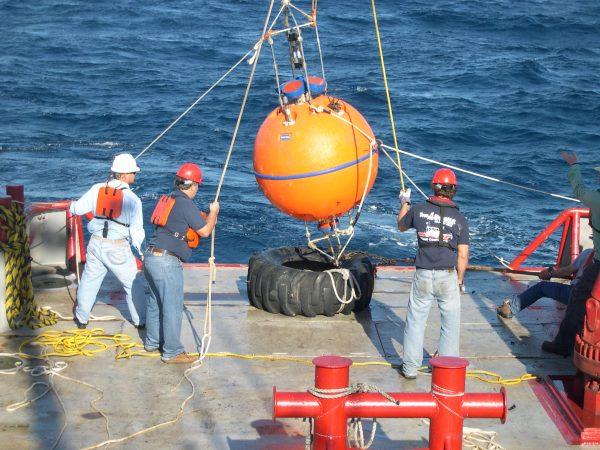
Ocean Data Technologies recovering a spherical ADCP buoy 8 miles outside of Port Everglades, Florida, in the Florida Current (Gulf Stream), aboard the M/V Richard L. Becker. The ADCP mooring was for Dr. Alexander Soloviev of Nova Southeastern University. It was deployed for nearly 4 years, with regular 6-month turnaround operations (like this one), recording an impressive data set of Gulf Stream variability.
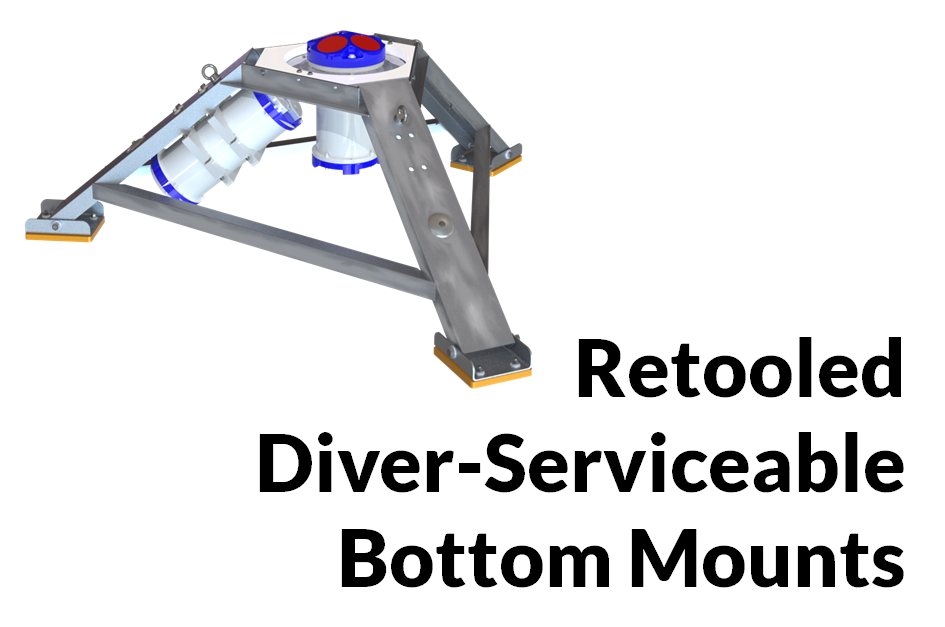
Aug 9, 2016
DeepWater Buoyancy has recently retooled the popular Diver-Serviceable Bottom Mount. In addition to improvements to the standard, welded bottom mount (BTM-AL50-A), a fold-able version was designed to reduce shipping costs, minimize space on deck and simplify handling for deployment (BTM-AL50-B).
Both of these rugged tripods come ready to accept your ADCP and remote battery canister, and can easily be modified to fit CTD, wave/tide gauge, velocimeter or other instrumentation. The frames can also be fitted with acoustically-released popup buoys.
BTM-AL50’s are manufactured using 5000 series aluminum and galvanically-isolated fasteners, and are fitted with zinc anodes for superior corrosion resistance. The standard double-axis gimbal keeps your ADCP oriented to vertical after deployment and is manufactured using ultra-high molecular weight polyethylene to deter marine growth. Fixed mounts can also be provided.
The units’ three foot pads are supplied with through holes for ballast or for spiking depending on your application. Standard (10lb/4.5kg) urethane-coated ballasts are provided for each of the three legs. Additional ballast is available upon request .
Download a datasheet HERE
See all our product types HERE
About DeepWater Buoyancy, Inc.
DeepWater Buoyancy creates subsea buoyancy products for leading companies in the oceanographic, seismic, survey, military and offshore oil & gas markets. Customers have relied on our products for over thirty years, from the ocean surface to depths exceeding six thousand meters.
For further sales information: Dan Cote, Sales Manager | sales@deepwb.com | +1 207 502 1400
For further company information: David A. Capotosto | davidcap@deepwb.com | +1 207 468 8545
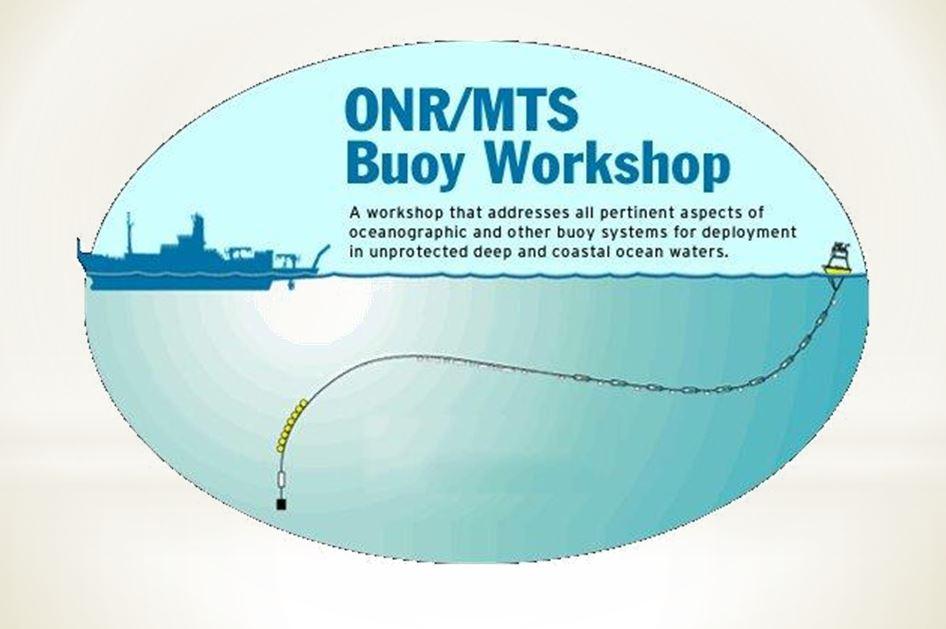
Mar 30, 2016
DeepWater Buoyancy is co-sponsoring and exhibiting at the 11th MTS Buoy Workshop sponsored by the Marine Technology Society (MTS).
The Workshop will be held at the Woods Hole Oceanographic Institution (WHOI), Woods Hole, Massachusetts, on Quissett Campus. The workshop will run from April 18-21, 2016.
To learn more about the event, CLICK HERE
On Friday the 22nd, participants have been invited to make the trip north to Maine for lunch and a tour of DeepWater Buoyancy’s Biddeford facility. Afterwards, participants can continue on and take a tour of the Yale Cordage facility in the neighboring town of Saco.
To sign up for the lunch and tour simply send an email to sales@deepwb.com.
To learn more about Yale Cordage, go to www.YaleCordage.com.
To learn more about DeepWater Buoyancy, go to www.DeepWaterBuoyancy.com.
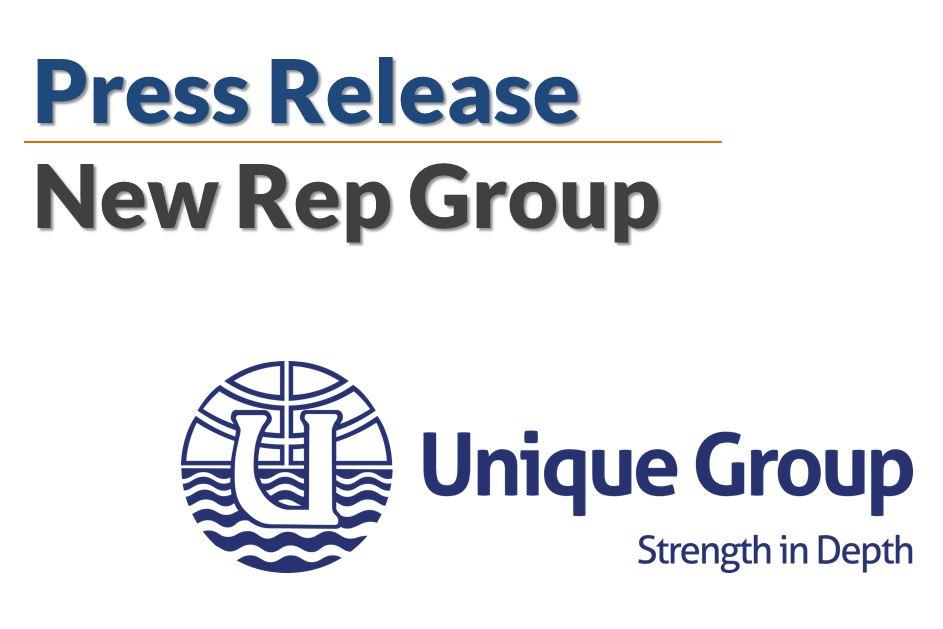
Mar 10, 2016
DeepWater Buoyancy, Inc. has announced today that it has entered a distribution agreement with Unique Group, a leading subsea and offshore service provider headquartered in the United Arab Emirates. Unique Group will act as sales representative and distributor of DeepWater Buoyancy’s subsea buoyancy products within the GCC region.
DeepWater Buoyancy has over 30 years of experience in engineering and manufacturing subsea buoyancy products for oceanographic, offshore oil and gas, and industrial companies around the world. The product line includes ADCP deployment solutions, mooring buoys, cable and marker floats, instrument collars, trawl-resistant bottom mounts and ROV buoyancy.
On securing this partnership, Sahil Gandhi, Executive Director at Unique Group commented, “We are excited about our new partnership agreement with DeepWater Buoyancy. Its products are high quality and are appreciated by customers across the globe. We’ve been dealing with oceanographic products for ADCP and other mooring solutions and to complete our product offering, we chose to partner with Deepwater Buoyancy in order to provide turnkey solutions in offshore oceanographic monitoring. We look forward to strengthening our customer base in the region with products such as the ADCP and mooring buoys, marker and cable floats, and the ROV buoyancy modules which are of special interest for projects within the GCC.”
David Capotosto, Co-President of DeepWater Buoyancy Inc. added, “The partnership with Unique Group is in line with our goal of expanding our global network of representatives. It reinforces our philosophy of local representation the world over, thus providing customers with the very best in technical and sales support. Unique Group is particularly well-established in the Middle East and is amongst the best sales and technical organizations in the region. We are excited about the opportunity for our products to reach a wider customer base in this region. We look forward to a great association with Unique Group in the years ahead.”
About Unique Group
Founded in 1993, Unique Group is among the world’s prominent integrated subsea and offshore solution providers. Through its five operational business divisions, Unique Group is a specialist in the provision of engineering, sales and rental of equipment for the marine, diving, and subsea market sectors. The group has an established manufacturing capability for the delivery of customized engineering projects worldwide. Unique Group is headquartered in Sharjah, Middle East and has a local presence in the USA, UK, Netherlands, South Africa, India, and Singapore and employs over 500 people worldwide.
For more information, please contact: Sharad Kumar, Group Business Development Manager | kumar@uniquegroup.com | +971 6 5130490
About DeepWater Buoyancy, Inc.
DeepWater Buoyancy creates subsea buoyancy products for leading companies in the oceanographic, seismic, survey, military and offshore oil & gas markets. Customers have relied on our products for over thirty years, from the ocean surface to depths exceeding six thousand meters. Contact us at www.DeepWaterBuoyancy.com
For further sales information: Dan Cote, Sales Manager | dcote@deepwb.com |+1 207-468-2565
For further company information: David Capotosto, Co-President | davidcap@deepwb.com | +1 207-468-8545

DeepWater Buoyancy’s 62 inch spherical ADCP buoy with integral frame, clamps and instrument pockets.

Feb 11, 2016
For the first of a series of technical articles, we asked our friend and ocean engineer Jon Wood to write a short article about the value of subsea mooring of instruments. Jon has decades of experience working with DeepWater Buoyancy’s ADCP deployment product line.
———–
Oceanographic moorings can be categorized as surface-based, sub-surface, or bottom-mounted.
Bottom-mounted moorings are generally fixed frames containing the sensor payload, and to ease deployment and retrieval, typically restricted to relatively shallow waters; say, less than 50m depth.
Surface moorings are used in all water depths from shallow areas to the deepest parts of the world’s oceans. Surface-based systems utilize a large buoy with sufficient reserve buoyancy to remain upright in all expected conditions. Think hurricanes and other storms. Surface buoys are required for real-time data telemetry for operational purposes or data security concerns. These buoys require warning apparatus such as radar reflectors and navigation lights, and are prone to damage due to storm systems, vessel collisions, vandalism, or theft. Further, buoy response to the surface wave field during energetic events can cause excessive motion of buoy-mounted sensors, such as acoustic Doppler current profilers, and thereby degrade the quality of data obtained from them.
Subsurface buoy systems offer an attractive alternative to these other techniques for several reasons. Installing buoys below the surface, and out of sight, relieves any risk of human tampering or vessel collision while left unattended. This is especially important in remote regions where much of our work takes place. Prudent design of a subsurface mooring system can position sensors optimally to provide high-quality observations less affected by higher-frequency motions resulting from near-surface energy. Because the sensors can be placed well below the surface layer, the improved sensor stability reduces noise and results in a superior measurement.
Two examples of the benefits of subsurface moorings come to mind. In 2005, Hurricane Katrina passed closely to our deep-water subsurface mooring at the time of near-peak intensity. Despite our worst fears, the mooring survived without any damage and was recovered successfully with full data capture. The mooring was designed to place an ADCP 80m below the surface, looking upward. While the storm kicked up massive waves and currents in the near-surface layer, destroying many rigs and other infrastructure in the Gulf of Mexico, our ADCP sat well below the action, quite stable, and provided extremely high-quality, high-resolution current profiles throughout the entire event.
In 2009, we were asked to measure high-speed turbidity currents in the deep Congo River canyon off West Africa. Turbidity currents are sediment-fueled, undersea ‘avalanches’ which destroy nearly everything in its path. Despite numerous attempts in this area there had been no success with direct measurement. Knowing turbidity currents are strongest near the seabed and decrease in intensity above, our subsurface mooring design used the same remote sampling approach as for Katrina, except in this case the ADCP was inverted. The ADCP was about 70m above the seabed and looking downward, at an elevation where currents were expected to be weaker. All supporting high-drag mooring components such as buoys and acoustic releases were also placed well above the seabed, out of the high-speed flow, attached to a large anchor with just a single length of thin-diameter wire. During this program we measured dozens of turbidity current events successfully with very high spatial and temporal resolution. The most intense event reached speeds exceeding 5 knots! In water depths exceeding 2000m!
These are but two cases where subsurface moorings can be designed optimally to record even the most energetic ocean processes.
About Ocean Data Technologies, Inc.
Ocean Data Technologies, Inc. is a Massachusetts (United States) corporation providing oceanographic data acquisition services and support to the global offshore marine industry. Ocean Data designs and installs simple, reliable systems that collect information critical to our customer’s needs in deep-water, continental shelf, as well as nearshore and estuary regions.
Contact us at www.oceandatatech.com
About DeepWater Buoyancy, Inc.
DeepWater Buoyancy creates subsea buoyancy products for leading companies in the oceanographic, seismic, survey, military and offshore oil & gas markets. Customers have relied on our products for over thirty years, from the ocean surface to depths exceeding six thousand meters.
Contact us at www.DeepWaterBuoyancy.com

Ocean Data Technologies deploys a subsea mooring with a DeepWater Buoyancy ADCP buoy.

Jan 11, 2016
At the request of one of our customers, DeepWater Buoyancy has recently completed the design, tooling and production of a new, stack-able marker float. Marker floats are used in ROV and Survey operations around the world. Due to their unique acoustic signature and high visibility coloration they are a popular choice for marking bottom location to facilitate ROV maneuvering.
The traditional marker float, which has been produced for over 30 years, is the shape of a U.S. football. The new design has a square cross section. The square shape provides an even stronger signature for location. It also allows stacking for more efficient storage and shipping. Like the traditional model, the “square” marker float is constructed with a durable, rotationally-molded shell and is filled with solid DeepTec™ syntactic foam. It is molded from a bright yellow polyethylene for visibility.
Both models provide the same amount of buoyancy and are the same price for a given depth rating. Standard models are available for 3000, 4000 and 6000 meters. Of course, like all other DeepWater Buoyancy products, if you have a special requirement for a different depth, just ask. We are glad to accommodate you.
To download a datasheet, click HERE
See all our product types HERE
For further sales information: Dan Cote, Sales Manager | sales@deepwb.com | +1 207 502 1400
